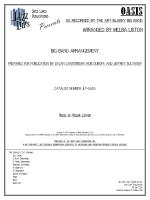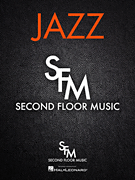OASIS
As Recorded by the Art Blakey Big Band
Arranged by Melba Liston, Prepared for Publication by Dylan Canterbury, Rob DuBoff, and Jeffrey Sultanof

Cat #: JLP-5455
$75.00This item usually ships within 1 business day.
Questions?
Please call +1-518-587-1102 or email us.
Edition: Jazz Big Band Arrangement
Description: Swing - Medium Difficult
Publisher: Jazz Lines Publications
Melba Liston's Oasis has a rather interesting history behind it. Originally, it was arranged for a 1957 recording session by the Art Blakey Big Band, but was not released, likely due to the band not being able to put together a take satisfactory to Blakey's standards. It is well-known that Art Blakey could not read music. And, due to the non-traditional nature of this arrangement, Blakey did not have a firm grasp on the form. With rehearsal time at a premium, the band read through one complete take of the arrangement and then put it aside. It did, however, eventually see the light of day on future remastered versions of the session, with some interesting pre- and post-take banter between Liston, Blakey, and other members of the band. It sticks out in comparison to the remainder of the material from the session due to its elastic sense of form, modernist harmonies, and unique structure.
The recording opts to skip the introduction and begin right on the melody at measure 9. Initially handled in unison by the trumpet section, the trombones eventually join in while the saxes play a support role. For the bridge, the melody shifts to a lower, gruffer sounding combination of trombones and tenor saxes. Blakey gets a four bar drum break at measure 35 to mark the beginning of a transition to a new key a few measures later. This middle section is largely dominated by a trumpet solo that contains both written and improvised parts. The previously skipped introduction makes an appearance at measure 57, with Blakey playing fills around the ensemble, followed by a copied-and-pasted reappearance of the melody. A short extended trumpet solo tag leads into the conclusion - a single unison note, followed by a rather harshly dissonant chord, returning back to the unison note once more.
The sole issued recording of this piece features several edits to Liston's original parts, such as the aforementioned skipped introduction, as well as some short trumpet solos that were left un-played. We have opted to include these features to allow you and your ensemble to replicate the piece the way Liston originally wrote it.
This publication was prepared from the original set of parts that were used for the 1957 recording session - this is not a transcription.
2 Alto Saxophones
2 Tenor Saxophones
Baritone Saxophone
4 Trumpets
3 Trombones
Guitar (Optional)
Piano
Bass
Drum Set
Trumpet 4: C6
Trombone 1: A4








